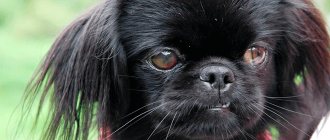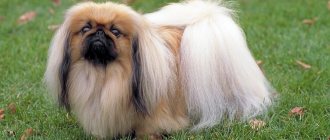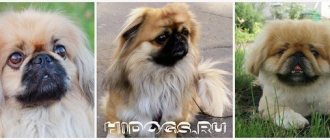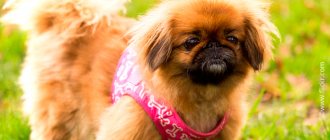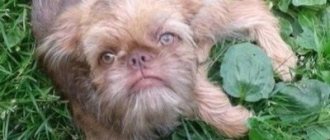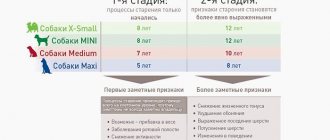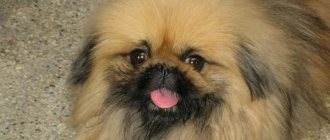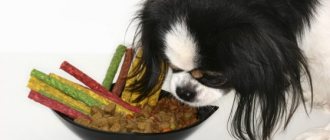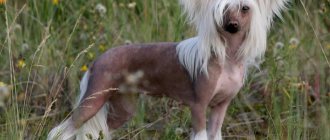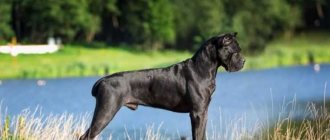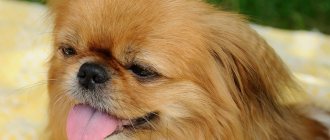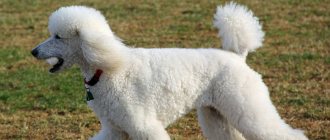Origin story
The history of the Pekingese dates back to Ancient China, where these dogs were bred more than two thousand years ago. There, Pekingese were considered a gift from Buddha and guardian spirits of the ruling dynasty, and therefore only members of the imperial family could keep them.
Taking Pekingese out of the territory of the Celestial Empire was considered a terrible crime, and the one who kidnapped the dog from the palace faced the death penalty.
But sometimes puppies, as a sign of special favor, were presented to people who had rendered special services to the imperial dynasty, and sometimes even foreigners were among them.
The Pekingese ended up in Europe after Beijing was captured by the British in 1860. The soldiers, having discovered five living dogs in the palace chambers, sent them as a gift to Queen Victoria.
In Britain, for some time they tried to use Pekingese not only as salon dogs and companion dogs, but also for hunting, guarding and herding sheep..
English breeders of the second half of the 19th century wanted to improve the original breed and make it more universal, however, all these attempts were unsuccessful, and the breed began to acquire features that were unusual for it.
As a result, it was decided to return to the original type, thanks to which modern Pekingese look almost the same as their ancestors from Ancient China.
History of the Pekingese breed
These are representatives of one of the oldest dog breeds living on our planet. Archaeological scientists have found bronze items depicting Pekingese, and their age is estimated at 4,000 years. For centuries, these little ones lived exclusively in the imperial family and were bred only for these purposes. After all, according to the belief of those times, it was the Pekingese who was responsible for protecting the emperor himself in the afterlife. Therefore, the royal person was buried only with his beloved pet.
When the British captured Beijing in 1960, several purebred representatives were taken from China and presented as gifts to Queen Victoria of Great Britain and the duchesses close to her. And the rest of the dogs were destroyed by the Chinese themselves.
It was from the royal dogs that the development of the breed in Europe began. A new round in the growth of its popularity occurred in the post-war period, and the Pekingese has not lost its position to this day.
Interesting Facts
- The white color of the Pekingese was not popular in their historical homeland because the white color in China is considered a symbol of death.
- The Pekingese first arrived in countries such as Germany, Holland and the USA in 1900.
- DNA analysis has shown that Pekingese are a breed related to pugs, papillons and even chihuahuas.
- Pekingese are considered one of the longest-living dogs, with many living 18-20 years.
- These dogs have become the heroes of many cartoons and feature films.
- Pekingese Puggy from the USA is considered the dog with the longest tongue, which reaches a length of 11.43 cm.
- The Pekingese almost became the most expensive dog in the world: 32 thousand pounds was offered by an American millionaire to Englishwoman Clarissa Ashton Cross for her dog, but she refused to sell her pet.
Pekingese: main ancestors
If we ignore the legends and turn to the real history of the breed, then in general today it is known that the Pekingese was bred over 2 thousand years ago in China (presumably in the 5th millennium BC). The name of the breed comes from the name of the city of Beijing. However, the Chinese prefer to call Pekingese Foo Dogs, and love them so much that they regularly dedicate various works of art to their pets.
According to numerous breeders, the Pekingese breed as a whole is not unique, because in history there are other dogs with a similar exterior. These include the Japanese Chin and the well-known Pug, which presumably descend from the same ancestor - the wide-faced Toy, previously popular in the Far East.
Dogs of the Toy breed became fashionable back in the 8th century AD - that is, during the Tang Dynasty, when they began to be actively bred throughout China and mentioned in works of Chinese literature. In Northern China, Toys were domesticated quite early, and then, through many years of careful selection, an athletic, long-haired and very aristocratic dog, similar to the modern Pekingese, was bred. It was she who, starting from the 16th century, was depicted in various paintings. In those days, the standard Pekingese dog had red and white fur and short legs.
Later, the Pekingese dog breed developed thanks to the Manchu dynasty, which developed a special breed of Toy, which was distinguished by its extremely small size. In China, such dogs began to be called “ha-pa”, which literally means “under the table” - due to their compact size, the animals easily fit under low Chinese tables. A little later, another “super-small” dog was bred, which was called the “muff dog”. She became a favorite of women and was highly valued.
It was then that the Pekingese became a real Imperial dog, which was bred at the court of the emperor, who had a developed network of nurseries. Only the best puppies from each litter were selected for breeding, and after some time a real cult of the Imperial Lion Dog appeared in the country.
Description of the breed
Pekingese are small, short, squat dogs with a proud posture, thick long hair and a short muzzle..
The head is quite large, its width slightly exceeds its length.
The ears are well furred and not too long. The eyes are round, widely spaced, dark and protruding.
Snacking is typical for this breed.
The body is rectangular in format, the paws are short with a moderately wide set.
The chest is deep, extending below the elbow joints.
The back is straight and moderately wide, the withers are weakly defined.
The tail is of medium length, set high and heavily feathered. It flies abandoned over its back and looks like a fan.
The coat is thick, elongated, forming a mane on the neck and shoulders, as well as feathering on the tail, ears and paws.
Any color other than white is allowed if it is associated with the albinism gene.
Description of the appearance of Pekingese
Representatives of this breed are small in size, regal in posture and have an unusual appearance. They are easy to recognize simply by the description of their exterior features:
- small strong body;
- short legs;
- a very fluffy tail lying on the back;
- ears tilted forward, with feathering;
- the muzzle is short, flattened, there is a fold on the nose;
- big round eyes.
Breed standard
The first breed standard was created at the end of the 19th century. Its modified version, adopted in 2004, is now in effect. According to it, the height of an adult Pekingese at the withers should not be more than 25 cm, weight - up to 5.5 kg. Unlike representatives of other breeds, females weigh more than males. Photos complement the description of the appearance:
Appearance
Appearance
Head
The head is large and wide in relation to the body, the muzzle is short. The forehead is flat, the transition to the nose is pronounced, almost at a right angle. A small fold of skin runs from the bridge of the nose to the cheeks. She shouldn't close her eyes. The nose is black, flattened, the nostrils are large. The lower jaw protrudes. The lips are black and thin. The teeth are small, without spaces, and meet in a tight bite. The ears are heart-shaped. Covered with fluffy hair, they hang down, fitting tightly to the skull. The tips should not fall below the nose. The Pekingese's eyes are round and always dark. Large in relation to the muzzle, widely spaced. May be slightly convex, but not protruding. The look is smart, a little surprised. The eyelids are black and do not droop. The pictures show the structural features of the Pekingese head:
Head
Muzzle
Body type
The body is rectangular, compact, the back is straight. The chest is wide, the ribs are convex, and the waist is clearly defined. The neck is short, powerful, completely hidden by fluffy hair. The tail is set high, lies on the back, and is often tilted to the side.
Limbs
Limbs are parallel, of medium length. The front ones are thick, set wider than the rear ones, and more powerful. Elbows pressed to the body. The hock joints are clearly defined and located low. Pekingese paws are large and flat. They move slowly, waddle, but confidently. They don't like to run, but they are resilient when necessary. The body features of the Pekingese are visible in the photographs:
Body type
Body type
Features of Pekingese wool
The coat is straight, hard, medium length. Forms a fluffy collar and feathers on the paws. The longest hair is on the ears and tail. The undercoat is soft and fluffy, so the coat forms a halo around the body.
Colors
Now the standard allows several colors of the Pekingese:
- the most common color is from golden to dark red, black tan is possible;
- fawn, milky or cream, sometimes with a black muzzle;
- black Pekingese are popular;
- black and tan and black with white markings.
A dog of any color may have a white spot on its forehead. In ancient China, such dogs were believed to bring happiness. The standard does not allow colors such as gray, red, spotted. Pure white Pekingese are also not recognized, but are valued by fanciers. Photos showing the characteristics of wool and the variety of colors:
Summer on the grass
Black color
Varieties
There are no such varieties as the Royal, Imperial or Chinese Pekingese. But representatives of the breed are divided into two groups based on coat type. The standard and most common are the long-haired Pekingese. There is also a smooth-haired variety. Most often, black and white Pekingese have short hair. They have no feathering, ears are not fluffy and there is no thick undercoat. Such dogs, like shorn long-haired dogs, are not allowed to exhibit. There is also a dwarf variety of Pekingese. This is not a separate breed, but a subspecies not recognized by the standard. The weight of mini dogs is no more than 2.5 kg; they are not allowed for breeding, as they cannot bear offspring. Such dogs appear with standard parents and are popular. Dwarf varieties existed in ancient times. The Chinese wore them in the sleeves of their kimono and called them sleeve dogs.
Character traits
Pekingese are balanced and calm pets with a somewhat arrogant and independent disposition. Despite their small stature, they are brave and fearless: they do not hesitate to accept a challenge and engage in battle with larger opponents.
These dogs are very smart and quick-witted, they are easy to train, but they can show stubbornness and even disobedience if it seems to them that the owner, forcing them to follow commands, is trying to manipulate them.
High ambition and the habit of considering themselves the center of the universe make Pekingese dogs demand adoration and even reverence from their owners.
The Pekingese is not a dog that will tolerate rude or inappropriate treatment.
However, the independent nature of these dogs and their self-sufficiency allow owners to safely leave home, leaving the pet alone. Pekingese, in the absence of the owner, will not damage the furniture or tear off wallpaper from the walls, but will find something more harmless to do.
Expert opinion
Kozhevin Semyon Kirillovich
Expert dog handler.
“Pekingese have a proud and independent disposition. These dogs, despite their small stature, carry themselves majestically and consider themselves the center of the universe. At the same time, Pekingese are calm, balanced and not mischievous, which makes them suitable as companions for working single people. But it’s better not to have Pekingese in a house with kids, as these dogs can’t stand being annoyed or teased.”
Pekingese dog: complete legends
The ancient history of the breed is shrouded in many legends, myths and secrets, and the most important secret is connected with the origin of these dogs. According to legend, the first Pekingese was the fruit of love between a Chinese lion and a beautiful young monkey who fell in love with each other. And it was from her amazing “parents” that this little dog received both grace and charm, as well as courage, dignity and a truly luxurious mane.
This romantic story is highly revered by fans of the breed and is often mentioned in ancient Chinese manuscripts. However, this is far from the only legend about the beautiful Pekingese. In addition to this, there are also numerous stories about how Chinese emperors adored these dogs, awarded them high titles and awarded them all kinds of honors. The first mention of such honors dates back to 1680: even then, Pekingese were considered an exclusive breed of the imperial family, and dogs awarded such an honor were required to wear luxurious headdresses and other insignia.
Advantages and disadvantages
pros:
- Calm and balanced.
- Beautiful.
- Smart and quick-witted.
- Well trained.
- Not prone to mischief.
- Even very busy people can keep Pekingese, as these dogs are self-sufficient and do not need constant communication with their owner.
- Loyal, although their love still needs to be earned.
- Their small size makes these dogs suitable for small apartments.
Minuses:
- Arrogant and independent disposition.
- They are so fearless that they can get into a fight with a stronger and larger opponent.
- Not suitable as pets for families with small children.
- They are ambitious and have their own worldview.
- They can be stubborn and self-willed.
- They are predisposed to a number of breed-specific ailments.
- They need daily coat care.
Breed standard
| A country | China |
| Purpose of the breed | Companion |
| Appearance | A small dog with long thick hair, a flattened muzzle and bulging eyes. |
| Temperament | Calm and balanced. By nature, it is a fearless, proud, wayward breed. |
| Options | Weight:
Height:
|
| Head | “Envelope head” with a wide and flat skull. The width of the skull is 1/5 greater than its length. |
| Muzzle |
|
| Neck | Thick and quite short. |
| Frame | Short with a defined waist.
|
| Tail | Set high, pressed tightly to the back and, bending, falls to the side. |
| Limbs | Straight standing, strong and strong. |
| Gait | Slow, smooth, waddle. |
| Wool | Thick, long, quite tough. Feathering on the back of the paws, fingers, tail, ears. A thick collar is formed around the neck and head. |
| Color | Any except chocolate (liver, brown) and albino. |
| Note | The male must have two apparently normal testes, fully descended into the scrotum. |
| Lifespan | From 12 to 16 years. |
Some experts classify the breed as a long-livers, saying that the Pekingese dog can live up to 18 - 22 years.
Is he good with children and does he get along with other pets?
Pekingese are good with school-aged children, who treat them with respect and gentleness.
But these dogs may not like very young children because of their noisiness, as well as the fact that small children are often too intrusive.
In this case, the Pekingese is unlikely to tolerate such treatment: at a minimum, he will snap at the child.
Often, communication between children and dogs of this breed ends in bites, albeit mild ones, as well as mutual insults.
Pekingese are able to get along with other pets, including cats, but only if they do not try to annoy or dominate them.
Breed traits
Breed traits (on a 5-point scale)
| Pekingese | |||
| Activity | in the house | 2.8 | |
| on the street | 3 | ||
| Obedience | training | 2.5 | |
| strangers | 3.5 | ||
| Domination | in family | 2.8 | |
| over dogs | 3.5 | ||
| Defending your territory | from people | 3.5 | |
| from dogs | 3.5 | ||
| Sociability | in family | 4.8 | |
| with strangers | 3.3 | ||
| with dogs | 3 | ||
| Concentration | in family | 1.3 | |
| in front of strangers | 3 | ||
| with dogs | 2.8 | ||
| Aggressiveness | in family | 1.5 | |
| to strangers | 2.3 | ||
| to the dogs | 3 | ||
| to cats | 3 | ||
| Family behavior | calmness | 3 | |
| demand for affection | 4 | ||
| excitability | 3.8 | ||
| playfulness | 3.8 | ||
| excessive barking | 2 | ||
| behavioral breakdowns | 1.5 | ||
| Tolerance for children | up to 4 years | 2.8 | |
| over 4 years old | 3.8 | ||
| Institutional use | watchman | 3.5 | |
| bodyguard | 2.3 | ||
This breed is often compared to the following dog breeds: Pug, Yorkshire Terrier, Shih Tzu, Pomeranian, Chihuahua.
Muzzle
Group photo
How to properly care
The Pekingese's coat should be brushed daily. Wash your pet 4-5 times a year, and it is recommended to use special shampoos for long-haired dogs.
Due to their short legs and lush coat, these dogs get very dirty during walks, therefore, it is advisable to take them out for walks in protective overalls.
You can also trim your dog's hair to make caring for it easier. But this can only be done if the Pekingese is not exhibited.
The pet's eyes and ears should be examined every day, and if dirt appears, cleaned with special drops or lotions applied to a cotton pad. The ear canal is cleaned with cotton swabs.
Teeth should also be brushed as needed and examined daily, this is especially important when changing baby teeth to permanent ones..
To clean the teeth, you can use a brush and dog toothpaste, or simply let your pet chew on special treats or toys purchased at a veterinary pharmacy or pet store.
It is recommended to trim the claws with a nail clipper as they grow..
Care and maintenance
Hair and skin care
If it were not for the long and thick coat, the care and maintenance of the Pekingese would become much easier. You will have to take care of the dog’s mane for at least 15 minutes every day: comb it first with a fine-toothed comb, and then with a massage brush (in no case with a slicker brush!), and untangle it from tangles. Particularly stubborn tangles can, in exceptional cases, be cut with special scissors with rounded ends.
Be prepared for the fact that during the shedding season, all carpets and upholstered furniture will be covered with a layer of wool. However, it can be easily removed with a damp sponge. If your pet attends exhibitions, he will need a lot of additional cosmetics: shampoos, conditioners, talcum powder, baby powder or dry powder shampoo. In hot weather, it is better to cut the dog's hair, as the breed cannot easily tolerate overheating.
Pekingese are bathed no more than once every six months. Before washing, to prevent the fur from getting tangled, comb the dog. When bathing, be sure to place a cotton swab in each of your dog's ears to prevent water from getting in there.
Once a day, the dog needs to be washed, the skin folds and especially the folds on the face should be wiped with a damp cloth, and the paws and belly should be washed after each walk. Dry the coat thoroughly and, if necessary, dry it with a hairdryer. The breed loves to lie in drafts and with undried hair can easily catch pneumonia.
A Pekingese should not wear a harness; it has the most negative effect on the condition of the dog’s coat and, accordingly, the exterior.
Eye care
The eyes are one of the Pekingese's weakest points. Because of their convexity, they are extremely susceptible to injury. Do not allow your pet to climb bushes or areas with dry grass or other thorny plants. Limit contact with dogs and animals that an undaunted dog might fight with. In a fight, it is the eyes that suffer first.
For daily care, a visual inspection is sufficient: if there is something “floating” on the cornea of the eye, carefully remove it with a damp cloth or cotton swab.
If an eye injury occurs, rinse it with a 2% novocaine solution as soon as possible and go to the veterinarian. If the eye comes out of the socket, cover it with a damp cloth, which must be additionally moistened every 10 to 15 minutes.
Caring for ears, claws and teeth
Your pet's ears, teeth and claws are regularly examined. Special beef bones, dog toothpaste, or regular soda applied to a gauze pad will help clean your teeth.
Nails should be trimmed regularly using a special nail clipper. If a vessel passing through the cavity of the claw is injured during a haircut, quite severe bleeding will begin. It can be easily stopped by firmly pressing absorbent cotton wool soaked in a 2% solution of hydrogen peroxide to the damaged area. Another way is to dip the claw in manganese powder.
Pekingese ears are cleaned using a dry swab. If accumulations of wax appear in the ear cavity, do not injure the delicate skin by friction. It is enough to purchase a special ear cleaning product from a veterinary pharmacy. If there is the slightest inflammation or unpleasant odor, take your pet to a veterinarian for examination.
Vaccinations and deworming
The Pekingese receives vaccinations according to the standard schedule. The first - from 2 to 4 months with preliminary (1 - 2 weeks before) removal of worms. Then after the time indicated on the vaccine package. And the third time - before the change of teeth, that is, at approximately the age of 7 - 8 months. The last, fourth time, the dog is vaccinated at 1.5 years. An adult dog is dewormed every three months.
It is not advisable to vaccinate your dog if:
- We didn’t have time to get rid of the worms.
- The pet is lethargic and refuses food.
- The temperature over the past three days has risen above 39.5 C.
- There was contact with a sick animal.
It is not advisable to vaccinate your Pekingese against ticks. It is quite toxic and poorly tolerated by the breed. To play it safe, give preference to special sprays: “Bars” or “Frontile”, or a collar.
How long do they live? Health and major diseases
The average life expectancy of modern Pekingese is 12-15 years.
However, if the dog comes from healthy lines and is properly maintained, it has a chance of living to 18-20 years of age.
Pekingese are a fairly healthy breed: they rarely get sick, but can be predisposed to a number of ailments associated with their elongated format and the specific structure of the head and muzzle:
- Progressive retinal atrophy.
- Cataract.
- Keratitis.
- Turn of the century.
- Dislocation of the eyeball.
- Cardiovascular diseases, including congenital or acquired heart and valve defects.
- Deformation of intervertebral discs.
- Respiratory diseases.
- Perianal adenoma (only in males).
Diseases characteristic of the breed
Eye diseases
You can often hear the phrase from Pekingese owners that if it weren’t for the eyes, the dog would be completely healthy. Due to its short muzzle and insufficiently deep eye sockets, the breed is extremely susceptible to injury and eye diseases such as:
- Eye loss.
- Conjunctivitis.
- Cataract.
- Ectropion (inversion of the eyelid).
- Corneal ulcer.
- Corneal erosion.
Other common diseases
- Urolithiasis disease.
- Congenital hydrocephalus.
- Eczema.
- Otitis.
- Myocardiopathy.
- Intervertebral disc herniation.
- Tracheitis and laryngitis (frequent diseases in the cold season).
- Periodontitis.
- Diseases of the cardiovascular system.
- Inflammation of perianal gland adenoma.
Nosebleeds are very common in the breed, caused by injuries, parasites, hypertension, viral or bacterial infections. As first aid, you need to drip your pet's nose with a special solution of hydrogen peroxide, naphthysine or adrenaline.
Nutritional features - what is best to feed? How many times a day?
You can feed the Pekingese with both natural food and ready-made high-quality food of premium class and higher. It is very important that the dog’s diet is complete, but not excessive, since overfeeding has a bad effect on the health of representatives of this breed.
When feeding naturally, the Pekingese should receive meat, offal, as well as raw or boiled vegetables and dairy products . Porridge should also be present in the diet, but they should not form its basis.
You cannot mix natural products with ready-made food or alternate them with it.
At first, it is recommended to feed the puppy as many times a day as in the breeder’s home, later the number of feedings is reduced.
Adult Pekingese receive food 2 times a day.
The best dry food:
- Acana Heritage Adult Small Breed
- Bosch Mini Adult Lamb & Rice
- Brit Premium Adult S
- Dailydog Adult Mini Breed lamb and rice
- Eukanuba Adult Dry Dog Food For Small Breed Chicken
- Farmina Cibau Sensitive Fish Mini
- Hill's Science Plan Canine Adult Small & Miniature Lamb with Rice
- Grandorf 4 Meat & Brown Rice Mini
- Purina Pro Plan Small & Mini Adult сanine Sensitive Skin Salmon and rice dry
- Royal Canin Mini Adult
- Wellness Dog CORE Small Breed Original
Character
These dogs are very friendly and love human company. The pet has a special connection with the owner; he feels all emotions and is very difficult to bear separation. The Pekingese's favorite pastime is to sit in the arms of its beloved owner.
Fluffy dogs are easy to train and love measured, calm walks in the fresh air. At the same time, the animal is quite freedom-loving. The owner will have to take into account his boundaries and position in the family. If your pet does not want to spend time with his family, but wants to be alone, you should respect his wishes.
Pekingese tend to be offended for a long time and show anger if the owner has offended him in some way. This can manifest itself both at home and on a walk. You should not provoke a small animal. Also, this baby is able to rush to the defense of his person without hesitation if he is in danger. They are very brave and determined.
Sample menu for the week
| Day of the week | Morning feeding | Evening feeding |
| Monday | Kefir (yogurt) + cottage cheese | Meat + stewed pumpkin + buckwheat porridge + flaxseed (olive oil) |
| Tuesday | Natural yogurt + cottage cheese + grated apple | Boiled liver + boiled carrots + vegetable oil |
| Wednesday | Ryazhenka (kefir)+cottage cheese | Meat + stewed zucchini + linseed (olive) oil |
| Thursday | Natural yogurt + cottage cheese + mashed banana | Boiled beef heart + boiled pumpkin + rice porridge |
| Friday | Kefir + cottage cheese + raw grated carrots | Boiled boneless fish + boiled carrots or zucchini + vegetable oil |
| Saturday | Natural yogurt + cottage cheese + grated apple | Meat + baked pumpkin + oatmeal + olive oil |
| Sunday | Kefir + cottage cheese + mashed banana | Boiled liver + boiled carrots + buckwheat porridge |
Pekingese clothes
The smooth-haired Pekingese needs special clothing all year round:
- In winter, this is a warm overall made of soft fabric with a synthetic padding lining.
- In wet weather, you can wear special waterproof overalls with a hood to protect your ears.
- In summer, you can protect your smooth coat from debris using a special mesh overall.
- Some owners also buy shoes for their pets, but rare dogs agree to wear them.
How to choose? Boy or girl?
Even if you are purchasing a pet and not a show-class puppy, you should buy a Pekingese from a nursery or a breeder. At the same time, when searching for a future pet, it is necessary to pay attention not only to the titles and pedigree of its ancestors, but also to whether this line is healthy.
In the litter, you need to choose a puppy that is moderately energetic and active, who does not show aggression towards other dogs in the kennel or towards people.
The baby must be completely healthy and look standard. He should not have too long or, conversely, short hair, and his color, if white, should not be associated with albinism.
IMPORTANT!
Experts recommend purchasing a female dog if you need a pet for your family and a male dog, or if you need a dog to participate in exhibitions, since male dogs usually look more impressive in the ring due to their richer mane.
However, it is not superfluous to take into account the fact that males are distinguished by a more stubborn and willful disposition, while females are softer and friendlier in character, they are more obedient and easier to train.
Pekingese mixed breed
Externally, the Pekingese is somewhat similar to another breed - the Japanese Chin . It happens that unscrupulous breeders try to sell Chin puppies by passing them off as Pekingese.
Therefore, it is worth paying attention to the following differences between these breeds:
- The Chin has a thin undercoat , so the breed is not fluffy. The Pekingese always has very thick, soft fur, if it is not yet a shed puppy. In an adult pet, the undercoat remains thick.
- The main color of Chins is white spots (black or red) on it . Pekingese can be any color, but there should not be too much white.
- An important feature is the paws . Chins have thin bones and graceful long legs, while Pekingese have wide legs and squat bones. This is worth paying attention to when choosing a puppy.
Important! When choosing a Pekingese puppy, it is important to understand that no one will give it to you before the baby is 2–2.5 months old. A purebred Pekingese has a brand on the belly, a passport and a pedigree, which must be provided to you upon first request (with photographs).
In order not to buy a Pekingese mestizo, pay attention to the following details:
- A flattened profile and a fold above it that should not cover it.
- The nose is wide and black . It hardly appears in profile.
- The legs are short , the front legs are wider than the hind legs, and have a natural curvature from the chest. A real Pekingese cannot have long legs, thin legs and other features of mestizos.
- The Pekingese's coat is thick at any age. If the fluffiness of a puppy makes you doubtful, it means that you have a mixed-breed puppy in front of you.
Nurseries in Russia and the CIS
In Russia, Pekingese can be purchased at one of the many nurseries:
- “Divine Flower” (Moscow)
- “From the Jasmine Palace” (Moscow)
- "Magri-Olifer" (Moscow)
- "San Ray" (Moscow)
- "Baltivskiy Kapriz" (St. Petersburg)
- "Elitlain" (St. Petersburg)
- "Ganko Saffi" (St. Petersburg)
- "Mirka" (St. Petersburg)
- "White Sun" (Chelyabinsk)
- "Image Dream" (Cheboksary)
- "Rumar Caprice" (Belgorod)
- "Savelina" (Novosibirsk)
- "Siberian Crown" (Krasnoyarsk)
In Ukraine, a dog of this breed can be bought in these nurseries:
- "Diantes Sanches" (Kharkov)
- “Julian Angel” (Vyshgorod)
- “Roman s Nadezhdoy” (Kharkov)
- “Waltz of the Flowers” (Dnepropetrovsk)
- "Eastern Dream" (Lutsk)
In Belarus, Pekingese can be bought at the Luchik Solntsa nursery, which is located in Minsk.
Contact details for nurseries can be found on their websites and social media pages.
Pekingese varieties
Due to the rich palette of colors, the appearance of Pekingese can vary greatly, but there are no official subspecies in the breed. Fans and ordinary people distinguish the following types of breed:
- Dwarf Pekingese, which is called hand, sleeve, pocket or mini. Dog handlers do not single out such dogs, because they are born from normal-sized parents. A reduced body is only a genetic defect that can only be noticed by the age of 8 months. Such pets should not be allowed to be bred.
- The Imperial or Royal Pekingese received the prefix to the name of the breed thanks to a marketing move by breeders. This title is added to pets to give them respectability and price.
Owner reviews
“Our Pekingese is a threat to the entire yard, he can attack a large dog, but he is affectionate and friendly towards people. He treats children well, but only when they pet him or play with him, but he does not tolerate insults - he growls and can bite, although more for show. Our dog has a good immune system, so he rarely gets sick, except for a slight inflammation of his eyes that he had once. There are no problems with nutrition, except for the fact that he is a terrible beggar: he loves to beg for goodies, standing on his hind legs, and he eats more willingly from his hands than from a bowl.”
“We bought our pet with documents, but the dog still turned out to be quite problematic. She has already had conjunctivitis three times, and due to the peculiarities of her bite, she has to grind her food, since she cannot chew large pieces. She is generally picky when it comes to food: she only eats what she wants. In addition, her fur has to be combed every day, and if this is not done on time, it becomes crumpled and tangled.”
“By the time we got our Pekingese dog, there was already a cat living in the house. The dog turned out to be very smart and obedient, did not annoy the cat, and did not pay attention to him at all. She didn’t spoil things, used the litter box to go to the toilet, ate natural food, and, in general, didn’t cause any trouble. But, unfortunately, we did not foresee that it would not be the dog who would be jealous, but the cat, who had already lived in the house for many years and whom we could not part with, and therefore we had to give our Dolly to our relatives.”
“Our dog was given to us by friends: they gave birth to a Pekingese puppy and one puppy remained unsold, so he ended up in our house. From the very beginning we liked the dog and we all loved her and tried to take good care of her. True, we have small problems with feeding: the pet will not eat everything, and she also loves bagels, although it is probably wrong to give them to her. Now that the dog is no longer young, she has health problems. However, despite this, she is still for us the best dog in the world, with whom we will never part.”
“Our Pekingese loves to walk outside and loves to roll in the snow. In mud or slush, you have to put on overalls on him, since he has a habit of stomping right through puddles. He treats children normally, or rather, indifferently, but only when they themselves do not touch him. Caring for him is not too difficult, except for the fact that he has to comb his coat every day and take him to a grooming salon for a haircut in the spring. By nature, the dog is quite temperamental and a little jealous, he loves when people fuss with him and pay attention to him, but at the same time he can be affectionate and even playful, but this, of course, depends on his mood.”
Pekingese care
The Pekingese is great for indoor living; it is not a breed that needs long walks or exercise. The dog will be happy to walk with you to the store, sit on a bench in the park, or walk sedately along the alley. Pekingese can run and frolic, but they do it for pleasure and according to their mood, and not on every walk. The Pekingese coat consists of two types of hair: long and coarse, and short and fine - undercoat. These dogs should be combed and combed as often as possible; this, firstly, makes them beautiful, and secondly, prevents their fur from rolling into tangles. On the paws, around the pads, the hair is trimmed, the claws are trimmed, and the folds on the bridge of the nose are wiped. Periodically, the dog is bathed with shampoo. The diet should be complete and balanced; Pekingese are very picky, so it is important to choose the type of food that the dog will eat with pleasure and at the same time receive all the necessary nutrients. Pekingese are characterized by some diseases, such as ectropion or cataracts, respiratory diseases, problems with the spine and musculoskeletal system, and heart failure. For breeding, it is preferable to take young females, even from their first heat. An older dog may die in childbirth if it is not given a caesarean section.
Training and education
To ensure that the dog behaves well and does not try to bully the whole family, education begins from a very early age: from the moment the puppy crosses the threshold of the owner’s house.
At the same time, you need to remember that despite all their stubbornness, Pekingese dogs remain companions. They are happy to please their owner, they are happy to do something interesting with him, they like to solve problems and perform tricks. The main thing is not to overwhelm or discourage the animal from learning by being too harsh.
Need to:
- Set clear rules. “You can’t jump on the bed.” “You can’t beg from the table.” “You can’t go to the toilet at home.” “You can’t bark loudly at night.” Every family member should know the rules and always adhere to them. If the puppy begs from the table, he is ignored. If he barks at night, he is scolded and sent to his place to sleep. If he jumps on the bed, he is removed from there. No “he’s so cute” or “I’m in a good mood today” or “I’m so tired and don’t want to get out of bed!” is not an excuse for letting rule violations pass.
- Don't forget about incentives. This is a common mistake: people remember to punish, but don't remember to praise. Meanwhile, praise is a much more powerful tool than punishment. Is your puppy quiet at night and sleeping on his own bed? In the morning he needs to be praised. Did he get out of bed on his own, obeying the command? This is worthy of encouragement. He doesn’t beg from the table, although he’s used to it and begged before? Why not pet him?
- Don't use harsh punishments. The main two methods of negative reinforcement that should be used are ignoring and dissatisfaction. This is quite enough to show your partner that he is wrong. If you shout at a puppy, if you hit or scold him, he will only get scared and angry. And an embittered dog becomes very stubborn and it becomes much more difficult to deal with him. Read on the topic: how to punish a dog for disobedience.
- Learn commands. Even a small lap dog that spends most of its time at home needs to be taught commands. Some of them can save her life - for example, “ew” or “come.” And the rest will provide the basis for interaction with the owner and food for thought.
A dog that is bored becomes a real disaster. But the one who is often dealt with, who is adequately encouraged and to whom dissatisfaction is clearly conveyed, will seem like a real angel to those around him.
